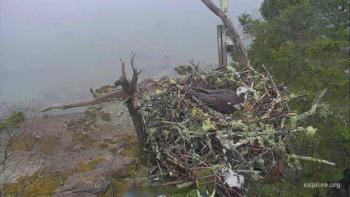A bonanza of Bird Cams
We wrote last week about the amazing discovery and documentation of a rare visitor to Maine, a vermilion flycatcher, at Hog Island via a remote observer watching one of the Audubon osprey nest webcams there. We remember when the first bird webcams made their appearance on the birding scene. The first ones that we recall were trained on peregrine falcon nesting platforms in big cities. During our time at the Cornell Lab of Ornithology more than a decade ago, people there were trying to pioneer some bird cams placed to watch the activities of other species. There was a barn owl cam and an eastern bluebird cam in the early days. The images were black and white and kind of blurry, and they may not have been truly livestreaming. They were novel and fun and gave views that had never been seen before but they were still a bit limited. Later, the Audubon Seabird Restoration program here in Maine started hosting a livestreaming webcam on Eastern Egg Rock that included sound. It was wonderful to be able to sit in an office 500 miles away and, with the sound livestreaming, feel as though you were sitting on a seabird nesting island in Maine surrounded by the cacophony of calls of laughing gulls and common and roseate terns.
Today there are an amazing array of bird webcams to enjoy that have seemingly television quality resolution and color, uninterrupted live streaming, and incredible sound. Many of these webcams have large numbers of utterly devoted watchers and chroniclers. The osprey web cams at Hog Island are among the most popular. Webcam devotees of the nest of the ospreys, affectionately named Steve and Rachel, have this year documented the exact times when Rachel laid each of her three eggs! Last year webcam watchers were horrified to see a bald eagle snatch the nestlings from the same nest.
The Audubon Seabird Restoration program now has webcams on Maine’s Seal Island National Wildlife Refuge where you can watch puffins and other seabirds live throughout the season. When we tuned in the day we wrote this it was fun to see the eiders and herring gulls in the fog as a song sparrow and a savannah sparrow sang close to the microphone.
The Cornell Lab of Ornithology has moved from its humble start in the bird webcam business to now being a world leader. From their website you can view many different live webcams (10 live as of this writing) ranging from the very popular red-tailed hawk nest on a building on the Cornell University campus to a Laysan albatross nest in Hawaii to a hummingbird feeder in Texas to a nesting burrow of the highly endangered cahow (Bermuda petrel) on Nonesuch Island, Bermuda.
Some other favorites of ours aren’t even bird webcams. One is the gray seal pupping cam that is also on Seal Island National Wildlife Refuge, though it’s not live now (tune in late winter) and the polar bear webcams from in or near Churchill, Manitoba.
So if you find yourself stuck inside or far away from a much-loved place, get online and watch and listen live through a webcam!
Jeffrey V. Wells, Ph.D., is a Fellow of the Cornell Lab of Ornithology. Dr. Wells is one of the nation's leading bird experts and conservation biologists and author of the “Birder’s Conservation Handbook.” His grandfather, the late John Chase, was a columnist for the Boothbay Register for many years. Allison Childs Wells, formerly of the Cornell Lab of Ornithology, is a senior director at the Natural Resources Council of Maine, a nonprofit membership organization working statewide to protect the nature of Maine. Both are widely published natural history writers and are the authors of the book, “Maine’s Favorite Birds.”
































.png)
.png)
